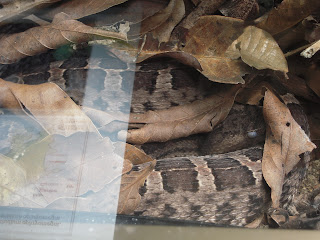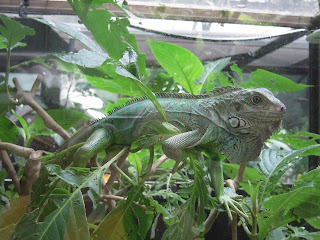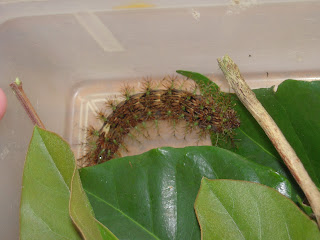Today I was able to walk down to the Butterfly Garden located just outside of Monteverde. Below you will see a lot of pictures of many of the creatures (more than just butterflies) that I saw today.
Here is an orange kneed tarantula that is laying on her eggs. These tarantulas can be found throughout Monteverde and they are found in small burrows in the ground. Luckily for us they would not bite us unless we stick our finger into its mouth, which I don't plan on doing anytime soon.
Here you can see one of the scorpions found in Monteverde. These can bite humans if provoked but would rather not and if they did it would just hurt like a bee sting. There are over 16 different species of scorpions in the area. There are two facts that I found surprising about these creatures. One is that they can glow under UV light which we were able to see. The second is that they give live birth to their young, usually about 50, and then young then stay on the mother's back for a couple of months.
This is a tailless whip scorpion that looks very scary but is in fact harmless.
These are a bunch of millipedes, many of which I have seen around Monteverde.
Here you can see the Hercules Beetle and the one on the right is the male while the female is on the left. Believe it or not there are over 400,000 species of beetles worldwide and make up 40% of all known animal species. Sadly though many insects are not studied by many and there are probably a lot more out there left to be discovered.
This is an Assassin bug also known as the kissing bug. This bug is responsible for causing Chaga's disease throughout the tropics. This disease can go undetected for 20-30 years before it "wakes" back up and causes heart attacks. They are found in Costa Rica but mostly around livestock, chickens, farms, etc.
Can you see me? I'm a leaf katydid! This is an insect that fits perfectly into its environment by looking like a dead leaf.
This is a caterpillar that in a few months will turn into a beautiful butterfly. What I liked most about him was the fact that he has the perfect camouflage in decomposing leaves and the hairs on his back keep predators away.
Both above and below you can see many pictures of butterflies. Some of them I was able to identify but not all. The gardens were set up in a wonderful way going from the lowlands of Costa Rica to the mid elevations and up to Monteverde. Each region had its own enclosed garden as well as a beautiful glass winged butterfly garden.
This is a Zebra butterfly, I wonder why. :-)
These two orange butterflies are Julia butterflies, which are named after the scientist's wife who discovered them.
Both here and below you can see the beautiful glass winged butterflies. I have seen these around Costa Rica but here was able to get some beautiful pictures.
This is a ruby patched swallow tail butterfly. We were actually able to release him because he had just recently come out of his cocoon so we were able to release him into the butterfly garden.
Another part of the garden was a large display of the leaf cutter ants. I have seen these ants all over Costa Rica so here it was good to learn a lot more about them. I was able to learn about the ant's social structure and how they each have specific jobs within the colony. They had a large enclosed box that had a tube leading out across this bamboo to the plants the ant cutters use to collect food and bring back to the colony.
Here is the ant colony and you can see all of the green leaf drops amid the food for the ants.
Tomorrow I will be heading back up into the Monteverde Cloud Forest Reserve to meet with Bernal who was my tour guide when I was here earlier in the summer with EARTH University. He is very interested in showing me around Monteverde Reserve so I can't wait!





















































